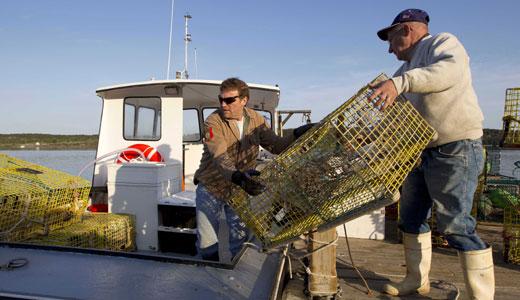
“Enough.” That’s what lobstermen along the Maine coast are saying in unison. The reason is simple. The price per pound of lobster offered to them by processors has dropped to $1.75. Seeing fuel and bait prices rise, the lobstermen are refusing to work longer and harder for less.
Lobstermen are quick to point out the inequities. The retail price of lobster for the consumer has not dropped. Where is the “magic” of the market place? The over supply of lobsters would diminish quickly with a lower market price. They say the only magic is the profits in the pockets of the owners of the lobster processing businesses.
Hardest hit are the stern men and stern women. While lobstermen own their boats via family heritage or bank loans, stern workers own only their labor power. They work the back of the lobster boats hauling the traps, removing the catch, marking pregnant females for throwback and rebaiting the traps. It is back breaking work. They earn 10 to 15 percent of the catch with no benefits.
The triple killers of capitalism are at work here- concentration of power (processors), the market and ecosystem imbalance or collapse.
The Bean family, of L.L. Bean fame, is an example of the continuing concentration of the lobster business in fewer and wealthier hands. Linda Bean has been buying up Lobster related businesses. In Vinalhaven, one of the lobster fishing centers along Penobscot Bay, she has purchased the Inland Co., Peter Jones and Shaft Masters.
The area is being fished intensely. In Vinalhaven alone, there are over 200 licensed fisher people. Each can lay as many as 800 traps. It is estimated there were close to 3 million traps in Maine waters before the work stoppage. Lobsters are considered fished even though they are technically crustaceans or hard-shelled animals.
Looming over the industry is the potential of market induced ecological collapse. There is a history of over fishing along the Maine coast. Cod were fished out in the 1940s. Flounder all but disappeared in the 1980s.
A further ramification has been the removal of predators of lobsters. As the lobster population has grown, the threat of disease grows with it. Ecosystem imbalance can potentially extract a high price on the industry, workers in the first place.
A good example of the perils of ecosystem imbalance comes from Africa. In the 1970s, the Gnu (wildebeest) population soared. The natural predators (like lions and crocodiles) of these hoofed animals could not keep up with the population explosion. A viral disease hit the herd, greatly reducing the numbers of Gnu.
Another wildcard is the warming of the waters in the Gulf of Maine. Water temperatures have been gradually rising since the 1870s. However, the last decade has seen rises in the 2 to 5 degrees range. The variation depends on the depth measured.
Viruses abound in ocean waters. Will the warmer waters generate a viral infection of these abundant shellfish?
Meanwhile, lobster boats are stilled while the people who do the work demand a just price for their toil.
Photo: Two workers load lobster traps in Mount Desert, Maine before the work stopped. Robert F. Bukaty/AP












Comments